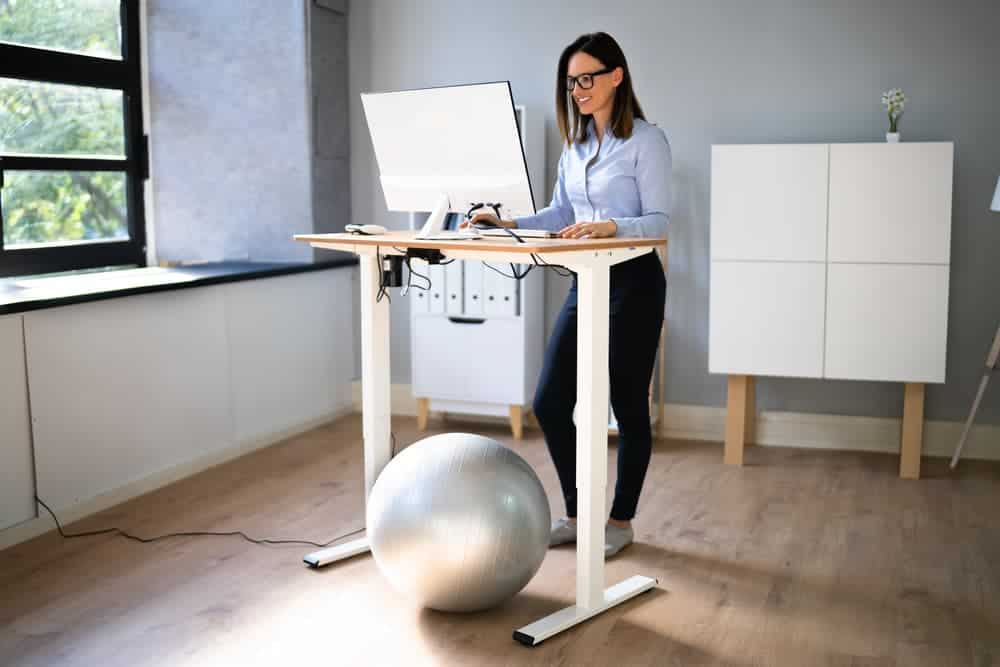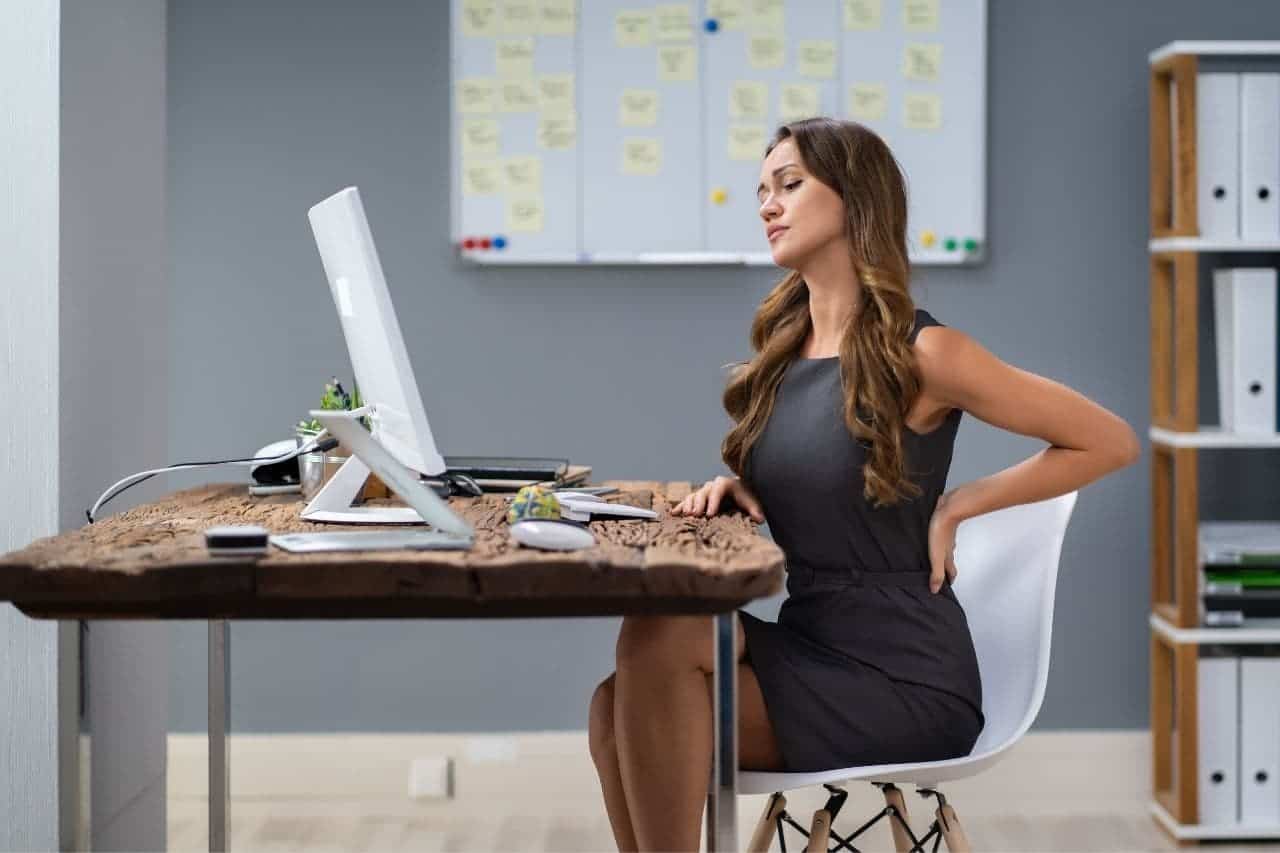People had minimal access to industrial, high-tech innovations in the past. Today, while technology made work quick and easy, it led to more sedentary living and increased health risks.
But we can always put advancements and good health together. Read on to find out how to reduce sitting too much at work. Then, follow my tips to start fighting the effects of the sitting disease.
Why Break Sedentary Office Habits
The American Heart Association reports that indulging in sedentary behaviours poses higher risks for cardiovascular diseases. Experts also suggest standing and moving around more to prevent musculoskeletal conditions.
To counter these, we need to break poor office habits. Good thing there are several methods how to sit less at work. Some easy but effective tweaks you can do include:
- investing in a sit-stand desk or adjustable workbench
- changing positions throughout your workday
- riding a bicycle or walking on your way to work
- going for active lunch breaks
- using compression socks or stockings
- taking deep breaths during the workday
- moving as much as you can
- engaging in office-friendly exercises and stretches
Let us expound more on these tips in the next half of this post.
How to Minimise Lack Of Movement At Work
Currently, most jobs in the country are desk-bound. And spending long hours hunched over daily tasks can do more harm than good. So, it’s more important than ever to focus on your health and avoid work-related illnesses by doing these tips.

1. Invest In A Sit-Stand Desk Or Adjustable Workbench
Yes, you have to spend on a sit-stand desk, but its benefits far outweigh the cost in the long run. It has adjustment settings to fit your body type and encourage better posture.
Also, it allows free movement while at work. One study even states that using a standing desk for 6 hours each workday could prevent weight gain.
The University of Iowa also found that employees using sit-stand desks stood for an hour daily and walked 6 minutes to work.
That means, with this routine, they are burning about 87 calories more than their colleagues who sat throughout their shift.
Aside from these health benefits, sit-stand desks are versatile. You can use this type of furniture for other tasks and hobbies to make the most of your investment.
2. Change Positions Throughout Your Workday
If using a sit-stand desk in the office is not feasible, you can stand up and walk around the office. Refill your coffee or water bottle, go to the printer, walk to the hallways, freshen up or roll your ankles and wrists.
Any simple movement will do. If you want, use a timer to remind yourself to move every 30 minutes throughout your workday.
If you cannot follow the 30-minute movement break interval, don’t worry. The point of this tip is to make you move more and not to go by a strict schedule.
3. Ride A Bicycle Or Walk Your Way To Work
This tip depends on your office location and how distant it is from your home, of course. But when you can, why not skip the car and cycle your way to the office instead?
You can also commute if that’s possible. A UK study even noted that actively commuting employees had better body fat and BMI values than those who use cars.
Walking and cycling also provide other perks. For example, these activities can lower cardiovascular disease risks. Being active also promotes better concentration and reduces work strain.

4. Choose Active Lunch Breaks
Yes, you can also incorporate some form of activity even within your hour-long lunch break. Doing this may help in eliminating higher risks of work-related morbidity.
After all, any sort of motion done for a mere 10 minutes is still better than sitting still in the pantry. So, take a quick brisk walk to the nearby cafe, then swing by a restaurant that’s further away next week.
Instead of using the elevator, opt for the stairs when you can. You may also do a simple yoga routine while at your desk or sitting down.
Aside from burning calories, these activities can prevent the dreaded afternoon slump.
5. Use Compression Socks Or Stockings
We have always associated compression socks with athletes. But desk-bound workers will also find a pair helpful.
These socks, for instance, can prevent fatigue, discomfort, swelling and conditions like deep vein thrombosis (DVT) and orthostatic hypotension. Such conditions are likely when working overtime in the office or going on long-haul flights.
Wearing knee-high compression socks and stockings while sitting at work provides many benefits, too. Specifically, they can improve circulation, lower chances of blood pooling in the legs, boost lymphatic drainage and provide varicose vein pain relief.
6. Take Deep Breaths During Your Workday
Doing this ensures that you’ll get to move and, at the same time, get sufficient oxygen intake for better posture. Taking deep breaths will encourage you not to slouch in your chair.
It will also keep your back straight and prevent pain or fatigue. Deep breathing will help you calm down during a pressure-filled day, too.
So, breathe and spread out your chest and rib cage to let all that oxygen rush into your body.

7. Move As Much As You Can
Most of us can easily get preoccupied with work. Before we know it, we’ve ended our shift sitting down all day. Remember, poor office practices often lead to weight gain and heart diseases.
Not all workers are into sedentary work settings, though. One study even found that some desk-bound staff voluntarily incorporate physical activities into their workday.
And so, it’s high time we follow their lead and start researching how to reduce sitting too much in our workplace.
Park your car a few blocks away from the office, for example. Use the stairs to skip the elevator queue. Walk and talk to your coworker instead of sending an email or private message. Also, stand up while answering phone calls.
When doing this tip, start with easy-enough activities that you can quickly turn to habits.
8. Engage In Office-Friendly Exercises And Stretches
Finally, you can do a few exercises to counter sedentary office habits. There is a good range of moves that you can perform in your cubicle, whether you’re seated or standing up.
You can strengthen your muscles, do some stretches and perform brief aerobic moves. This fun workout from a Washington Post article should give you ideas. Try doing these or other exercises if you want to sit less at home, too!
Conclusion
Doing desk-based tasks is inevitable, considering that most of us work from home nowadays. Online know-how, expertise and opportunities appear to be in demand, too.
But while these work trends require us to sit for long hours, there are ways to make our office days more active. Hopefully, this article has taught you how to sit less at work and motivated you to take the next step.
Let’s start changing our work habits today and do our bodies and health a huge favour!

Informative Q&A
1. How to get rid of slouching?
Slouching leads to poor posture. One effective solution for this is to stand up and move around. You can also do simple realignment exercises to put those overlooked muscles back on track.
Remember to stretch and strengthen your chest, core and upper back muscles to improve your posture.
2. How to set up an ergonomic home office?
Investing in ergonomic chairs will do your body plenty of good since these chairs are adjustable and provide spinal support. These chairs will also keep the feet on the floor while the thighs remain parallel to the ground.
If you are using a computer monitor, make sure that it is in front of you. The keyboard’s height must be correct as well, so your shoulders stay relaxed. Read this article to pick out more tips in creating an ergonomic work environment.
3. What is the difference between an ergonomic chair and a normal office chair?
Ergonomic and traditional office chairs significantly differ in design. Ergonomic chairs feature adjustable seat heights and seat depth plus lumbar support. Check out this review and buying guide on kneeling chairs to learn more.
On the other hand, standard office chairs lack those features. These can maintain a body’s posture. However, their ergonomic counterparts function better in loosening up the body and preventing fatigue, aches and pains.
- 6 Benefits of Using Seat Cushion - February 20, 2024
- 4 Tips to Fix Uncomfortable Chair - February 19, 2024
- How to Position Lumbar Support on Ergonomic Chair - February 15, 2024

